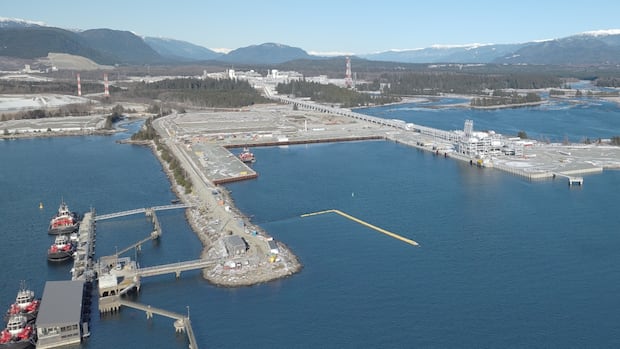There were high hopes ahead of LNG Canada’s startup that the project would provide a major boost to weak Canadian natural gas prices by opening up access to markets in Asia.
So far, at least, a spike in prices has yet to materialize.
LNG Canada began exporting cargo on Canada Day this year. Last month, the average Alberta benchmark price for natural gas was the lowest it’s been in the month of July since 1985, according to RBN Energy.
The project is considered the largest private-sector investment in Canadian history and expected to raise the country’s GDP by 0.4 per cent once it’s fully up and running. The project’s first phase is set to export liquified natural gas or LNG from two processing units, known as “trains,” with a total capacity of 14 million tonnes per year, said LNG Canada in a news release July 1.
But according to Jeremy McCrea, managing director of energy research at BMO Capital Markets, “there was a misalignment of expectations of when [LNG Canada] would be fully ramped up.”
“Producers brought on more gas than what was anticipated here versus the demand pull that we were going to see,” said McCrea.
“As a result, we have an oversupplied basin here as LNG Canada continues to ramp up.”
Prices dipped in 2024
The roots of the situation date back further than just this summer.
In 2024, prices for Canadian natural gas hit a 40-year low, according to Statistics Canada. The agency says production ramped up, particularly in B.C., in anticipation of the LNG Canada project coming online. This led to a supply glut, a situation that was worsened by warm weather in North America leading to lower commercial and residential demand for natural gas.
Weaker than expected prices for natural gas in recent months have also been linked to maintenance on pipelines that move natural gas out of the Western Canadian basin.
During their recent earnings calls, both Tourmaline Oil and Arc Resources pointed to pipeline maintenance as a short-term pinch point for prices. The companies said the situation should improve in the second half of the year, at which point the ramp-up of LNG Canada should also be further ahead.
In a statement to CBC News, a spokesperson for LNG Canada said initial operations have started with Train 1, and that production will continue to ramp up as it engages Train 2 and gets into a regular shipping cadence.
At that point, the statement said, “we anticipate loading one export cargo from our facility every two days.”
Once LNG Canada is running at full steam, it will engage about 15 export tanker vessels a month, according to a recent RBC note to investors. So far, three export vessels sailed from the facility in July and seven are expected to sail in August, the note said.
Hit to government revenues
In a certain sense, persistently cheap prices for Canadian natural gas may have been a good thing for consumers by taking some pressure off of utility bills, said Heather Exner-Pirot, director of energy, natural resources and environment with the Macdonald-Laurier Institute.
But she noted the longer that prices stay low, the greater the hit to government revenues in provinces like B.C. and Alberta, which count on royalties from natural resources.
In a statement, a spokesperson for the B.C. government said its natural gas royalty revenue dropped by $82 million in the 2024-2025 fiscal year compared to Budget 2024 due to lower prices for natural gas, and reduced royalty rates applied to new wells.
A spokesperson for the Alberta provincial government said it’s too early to weigh in on the impact of oil and gas prices for this year, but that it plans to give a first-quarter fiscal update at the end of the month.
In July, the average benchmark price for Canadian natural gas in Canadian dollars was $0.76 per gigajoule (GJ), according to RBN Energy. As of Aug. 13, prices this month ranged from less than $0.40 per GJ to just over $0.90 per GJ.
McCrea, with BMO, said it’s unlikely a glut of natural gas will continue to be a problem in the next year, with producers already taking a more cautious approach compared to the record production of 2024.
Exner-Pirot said she, too, is expecting a more balanced situation by 2026, though she noted the nature of commodity prices is that predictions can often be proven wrong.
“I would [have thought] that we would already be seeing different prices than we’re seeing right now,” said Exner-Pirot. “So, my crystal ball is broken.”

